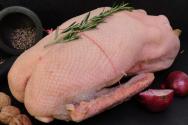Spring mushrooms: morels and strings. Edible or poisonous?! Stitch mushrooms: beneficial and medicinal properties What a morel and a stitch look like
Where do morels grow?
In some forest ravine there is still snow, and nearby, along the edges, like a formation of Scots guards in bearskin hats, there are morels. The shape of their cap gave the name to one of the two types of mushrooms that most often end up in our baskets - the conical morel. The representative of the second species, the edible morel, has a more rounded, ovoid cap.
Morel mushrooms grow in different places. You can find edible morels in the forest under deciduous trees, shrubs, in ravines - on soil fertilized with humus. Another edible species - the conical morel - can appear in a large group right in a clearing in a mixed forest, or even along a forest path on sandy soil. There is no particular gastronomic difference between them. They are almost identical in aroma and taste. Except that the flesh of the conical one is drier and when cooked it is firmer, with a distinct “crunchiness”.
Another representative of morels stands out among them - the morel cap. She, like the conical morel, does not like shade: whole broods of these mushrooms come out to bask in the May sun on the side of roads, clearings and burnt areas. Its peculiarity is that the thick hollow stem occupies almost three-quarters of the mushroom by weight, and the cap, in which all the aroma is concentrated, barely covers its top. And even if you pick up a basket full of caps alone, you will immediately feel the difference with morels: the aroma of the morel cap is poorer.
How to distinguish morels from lines?
The morel is often confused with the string, although it belongs to a different family and the difference between them is obvious - they don’t look the same, and the taste is not the same. The stitch, as a rule, stands on a short hollow stem, which is almost invisible from under the shapeless dark brown or even black cap. The stitches are much larger in size than morels.

On one small burnt area you can sometimes collect two or three buckets of stitches, and each one will be the size of a good grapefruit. In terms of gastronomic properties, the string is inferior to morels, but its aroma is excellent. More mushroomy, spicy. Maybe not so subtle, but also bright and memorable.
Is it possible to get poisoned by lines?
Our line has a bad reputation (and sometimes it also applies to morels). There were, they say, cases of poisoning. At first it was believed that the problem was some kind of poisonous gelvelic acid (its name comes from one of the mushrooms of the family - gelvels: perhaps in September-October you came across this unsightly mushroom on a thick gray stalk - it is sometimes mistaken for a line that came from nowhere in the autumn) . This version was not confirmed, and then a new culprit was appointed - the toxin gyromitrin, named after the Latin name of the line.
Morels do not seem to contain gyromitrin (in any case, research by the English scientist R. J. Benedict points to this), but the label of a suspicious mushroom has not been removed from it. Almost any book that admits that morels can be eaten talks about the need for preliminary heat treatment. Such recommendations can reach the point of absurdity - for example, one recently published cookbook suggests boiling morels for an hour before cooking, and then, of course, draining the water. Interesting: every spring I collect, cook and eat these mushrooms - and for many years now I have limited myself to simply washing them with running water and then stewing them. True, I collect morels in a certain place - the southern Ladoga region. I won’t vouch for other regions - you never know what excellent mushrooms can mutate into under the influence of poor ecology. See for yourself. But do not forget that by boiling the morels once again, along with the water you will pour that unique aroma of the forest awakening from hibernation into the sink.
How to cook morels? Best Recipes
Morels are used in different ways. It is better to prepare the first basket brought from the forest as simply as possible. Save the delights until next time. Now shorten the prepared morels, leaving the stem a centimeter from the bottom edge, and cut the mushrooms crosswise into rings. Fry them in melted butter, transfer to a cocotte maker, add salt, add sour cream and place in the oven for 15 minutes. This simple recipe will allow you to fully experience the taste of this spring natural phenomenon.
Now you can bake an old Russian unleavened pie with morels. The dough for it is made very rich, crumbly - with sour cream, butter and yolks. Roll it out into two juicy slices - smaller and larger, on the smaller one lay out layers of fried morels with two tablespoons of fat sour cream added at the end of frying, boiled rice, egg and fried onions. Rice, of course, occupies the bottom layer in such a pie. Cover the top with a large juicy layer, carefully pinch and bake.
And in traditional Russian kulebyak, morels will be combined with other main fillings - meat or fish. If you have it layered with unleavened pancakes, place the mushrooms on the top “floor.” If you decide to make a kulebyaka in four corners, place morels with rice or egg in one of the corners.
Prepare homemade noodles from a mixture of wheat and buckwheat flour (in equal proportions), boil it and mix with morels or strings stewed in cream. Noodles made from buckwheat flour alone with mushrooms will be even more expressive, if you know how to roll them out, be sure to do so. Buckwheat generally goes well with wild mushrooms. And simple buckwheat, and buckwheat flatbreads in the company of morels will make a very favorable impression (as, by the way, will pearl barley, but it’s not for everyone).
Morels, like other mushrooms, can be dried and frozen. Drying changes their smell and taste - a new product is obtained, valuable and unique. When frozen, even the most perfect one, the taste of morels is, of course, lost - but it allows you to organize culinary exercises all winter. Mushroom years do happen, when New Year's table you can put out the sauce with morels, and even in March prepare the famous Annunciation kulebyaka.
Read more recipes on the website gastronom.ru
Stitches (Gyromitra) - with a brain-shaped convoluted surface of the cap and partially fused edges.
Sometimes all genera and types of stitches are called morels. Strings grow more often in early spring in forests, parks and steppes.
The most common are the true morel (M. esculenta), the steppe morel (M. steppicola), the morel cap (V. bohemica) and the common morel (G. esculenta), which grows in pine forests.
These types of stringworms are used for food. The fruiting body of the common stringworm (Gyromitra esculenta) is similar to the brain or Walnut.
The cap has numerous convolutions, is hollow, irregularly rounded, folded and divided into many lobes, its surface is velvety in appearance, its color can vary from yellowish-brown to reddish-brown - depending on the location and growing conditions.
The diameter of the cap is usually 2-10 cm, its edges are connected to the stem.
The leg is usually irregular in shape, short, wrinkled, furrowed, often immersed in the soil, slightly thickened downward, hollow inside, light in color, sometimes has a yellowish-pinkish tint, 2-3 cm in length and the same in diameter. Found in coniferous, especially pine, forests; in clearings, fires, and sun-warmed areas.
The common stitch has a strong resemblance to the giant stitch (Gyromitra gigas), which is distinguished by a lighter cap color, larger size (up to 30 cm in diameter), spore structure and place of growth (gravitates towards birch). Both species, like morels, grow in the spring, from late April to late May - early June.
In contrast, the autumn line (Gyromitra infula) is found from July - August, in coniferous and deciduous forests on the soil, as well as on the remains of rotting wood. The autumn cap is usually up to 10 cm wide, folded in shape, brown, becoming brownish-blackish with age, with a velvety surface. The shape of the cap is horn-saddle-shaped (more often found in the form of three fused horns), the edges of the cap are fused with the stem. The leg is 3-10 cm long, up to 1.5 cm wide, hollow, often laterally flattened, the color varies from whitish to brownish-grayish.
Strings are considered a deadly poisonous mushroom containing a strong toxin - gyromitrin.
The taste and smell are pleasant. It is found rarely, on the edges of forests, in clearings, on roadsides, and the edges of ditches. Grows from March to May. The line is often confused with the morel. These mushrooms have different cap shapes.
The line is irregularly rounded, the morel is ovoid. In some countries it is considered a delicacy. It is prepared by drying (at least 30 days) during which the gyromitrin toxin evaporates.
Has medicinal properties. Tincture of lines relieves pain by rubbing into the skin.
However, the line contains a toxic substance that can cause severe poisoning, so before cooking the mushrooms should be finely chopped and boiled, after which the broth should be drained (it also removes the toxic substance, which is easily soluble in hot water).
Dried stitches are considered harmless.
In recent years, a toxic substance, gyromitrin, has been discovered in the lines, which cannot be removed from mushrooms by boiling. However, its content in the lines varies depending on the places where the mushrooms grow. Gyromitrin was found in large quantities in the common line (spring) growing in Germany.
In some years, this fungus caused poisoning in people there. Experts suggest that among the common (spring) line there is a variety in which gyromitrin accumulates especially intensively.
Grows in April, June. Productivity is subject to significant fluctuations. Common stitch is most often found in pine forests with sandy soil in places where the soil layer is disturbed.
When searching for mushrooms, maximum attention should be paid to the sides of old forest roads, old clearings, paths, ditch dumps, burnt areas, clearings and other places where there are emissions of the mineral layer (planted areas should be avoided).
Massive growth of lines in a small area is often observed. Sometimes there are huge, weighing several kilograms, mushrooms with fused caps and several legs.
Stitch mushrooms - Video.
The giant string grows in deciduous and coniferous forests with an admixture of birch, mainly on sandy soil rich in humus, in April - May, in groups, less often singly.
 The fruit body is very large, 5-15 cm in height, up to 30 cm in width. The cap is shapeless, with a wavy-folded surface, light brown or ocher-brown, almost completely attached to the stem.
The fruit body is very large, 5-15 cm in height, up to 30 cm in width. The cap is shapeless, with a wavy-folded surface, light brown or ocher-brown, almost completely attached to the stem.
The irregular, brain-shaped cap can reach an impressive 40 centimeters in diameter and up to 20 in height. The cap attached to the stem has an ocher or reddish color.
The structure of the cap, like the legs, is hollow. The leg is low, practically does not stand out from under the cap, off-white. The pulp is white, watery, without much taste or smell.
These lines grow in coniferous and deciduous forests and plantings. Since they are spring mushrooms, you need to look for them in places well warmed by the spring sun.
Typical habitats of giant strings: edges, edges of roads, hillocks, edges of ditches, fires, clearings. The leg is whitish, dirty white below, watery, hollow, 3-6 cm long, sometimes very wide.
The mushroom is conditionally edible. Used for cooking only after boiling and removing the decoction.
Appears in spring. The cap has sinuous folds, wrinkled, hollow, from dark brown to light brown. The smell is strong and pleasant. In its raw form it is deadly poisonous. After boiling and drying, it is safe. Delicious mushroom.
 The species is distributed throughout the country. It grows in April-June, in Lapland it is found even in July. Productivity is subject to significant fluctuations. Common stitch is most often found in pine forests with sandy soil in places where the soil layer is disturbed. Mushrooms are also found in other places.
The species is distributed throughout the country. It grows in April-June, in Lapland it is found even in July. Productivity is subject to significant fluctuations. Common stitch is most often found in pine forests with sandy soil in places where the soil layer is disturbed. Mushrooms are also found in other places.
When searching for mushrooms, maximum attention should be paid to roadsides, paths, ditch dumps, burnt areas, clearings and other places where there are emissions of the mineral layer (planted areas should be avoided). Places where wood is stored and debarked are productive. By following the old track of a forestry tractor, you can also reap a good harvest. Sometimes there is massive growth of lines in a small area.
There are also huge fruits, weighing several kilograms, with fused caps and several legs.
From the rhizinaceae family (Rhizinaceae). The cap is 2-13 cm in diameter, first chestnut-brown, then dark brown, irregularly rounded, brain-folded, hollow.
The leg is 3-9 cm high, 2-4 cm thick, whitish, grayish, yellowish or reddish, cylindrical, grooved or folded, often flattened, hollow, dry. The pulp is whitish, waxy, very brittle.
The taste and smell are pleasant. It is found quite rarely, on sandy, non-turfed soil, on the edges of forests, in clearings, on the sides of roads, paths, and the edges of ditches. Fruits from March to May. Sometimes the common stitch is confused with the morel. These mushrooms have different cap shapes. The line is irregularly rounded, the morel is ovoid.
To obtain large yields, experiments were carried out on the artificial destruction of the soil root-containing layer to the mineral layer. Encouraging results have been obtained that will make themselves felt already next year. The maximum yield from the experimental plot was harvested in the fourth year.
The efficiency of the site is about ten years. You can experiment with stitching if there is a suitable area of forest. This does not mean that a forest belonging to another owner can be plowed down to the mineral layer, despite the right of a Finnish citizen to pick mushrooms and berries in any forest.
Currently, the issue of cultivating the common mushroom as one of the most valuable mushrooms for use in food and marketing is being studied.
The toxin of the common mushroom is gyromitrin, which is best removed from the mushroom during drying. The second way to remove gyromitrin is to boil the lines. Boil mushrooms for 4-5 minutes in plenty of water. The water is drained after boiling.
For greater guarantee, mushrooms should be washed in water after boiling. cold water. When cleaning, the caps should be cut in half, since the voids in the caps are a favorite place for snails. You can get rid of stuck grains of sand at the collection site by cleaning the caps with a small hard brush, as well as vigorously washing the mushrooms in water. Mushrooms that have not been cleared of sand should not be boiled, as the grains of sand cut deeply into the pulp.
Drying is one of the safest and most reliable methods of preserving string, especially since drying its taste noticeably improves. It is best to dry in a well-ventilated area, above a heat source, at a temperature no higher than 50-60° C. Ovens unsuitable for this purpose due to lack of ventilation.
Drying stitches in large quantities in a residential building is not recommended, since the evaporating toxin can affect your well-being, especially since for some people prone to allergies, the smell of the stitches itself is unbearable.
Well-boiled (the water is drained, the mushrooms are washed in running water) or well-dried strings can be used in a wide variety of delicious dishes. Ground dried stitches are a good seasoning for sauces and other dishes.
Similar to the common, but larger, giant stitch (Gyromitra gigas) has a cap that is pale yellow to yellow-brown in color and less folded than that of the common stitch. The leg is short, thick, with small indentations. The giant string grows in dense deciduous forests and parks, adhering to areas overgrown with grass. The smell and taste are not as strong as that of ordinary string. A good edible mushroom, after preliminary boiling or drying. Found locally in southern and central Finland.
GYROMITRA INFULA-STITCH AUTUMN
Other names: horned stitch, inviolable gyromitra, smarzhok.
 Habitat: Found sporadically in July, but active growth begins in late August.
Habitat: Found sporadically in July, but active growth begins in late August.
Often found in small groups of 4-7 specimens in coniferous and deciduous forests on the soil, as well as on the remains of rotting wood.
Description: Cap: usually up to 10 cm wide, folded, brown, becomes brownish-blackish with age, with a velvety surface.
The shape of the cap is horn-saddle-shaped (more often found in the form of three fused horns), the edges of the cap are fused with the stem.
Leg: 3-10 cm long, up to 1.5 cm wide, hollow, often laterally flattened, color can vary from whitish to brownish-grayish.
Flesh: fragile, cartilaginous, thin, whitish, wax-like, without much odor, very similar to the pulp of related species, such as gyromitra esculenta (common stitch), which grows in early spring.
Conditionally edible in the fourth category: the mushroom is eaten only after preliminary boiling (drain the broth).
Lookalikes: Due to its unique appearance and growth time, the mushroom cannot be confused with any other species.
Notes: Conditionally edible, category 4, used as food after boiling (15-20 minutes, drain the water) or drying. In its raw form it is deadly poisonous. There are opinions in the literature that poisons (gyromitrins are strong toxins, hydrazine derivatives R=N-N(CHO)CH3) do not completely disappear after boiling (drying) and that toxic substances can accumulate in the body, which is why the lines are not recommended for use in large quantities quantities.
In Europe, like other string mushrooms, it is considered poisonous. Although this mushroom can be eaten, it is worth noting that, like gyromitra esculenta (common string mushroom), it is deadly poisonous in its raw form.
If prepared incorrectly, it can cause very serious poisoning. You should not eat it often, since the toxins it contains have cumulative properties and can accumulate in the body.
A huge variety of mushrooms grow on the territory of Russia. Some species can be collected in early spring, others - closer to autumn. Stitches can be found in the forest area. Mushrooms are not safe for inexperienced foragers. They can easily be confused with morels. There is no unanimous opinion among experts regarding their toxicity. Some believe that no heat treatment destroys the poison of mushrooms, others believe that after appropriate processing they can be eaten. Russian sanitary doctors classify them as conditionally edible mushrooms.
Description
Stitch mushrooms (photo in the text) can be compared in appearance to a crumpled sheet of brown paper. The fruit body is very unattractive, crooked and asymmetrical, with deep clumsy wrinkles, reminiscent of hanging crumpled rags.
Strog belongs to the genus of marsupial fungi of the Discinaceae family. Organisms that have septate mycelium and specific organs of sexual sporulation - asci - are classified as ascomycetes (translated from Greek as “bag”). That is why the stitch is called a marsupial mushroom. This group includes up to 20,000 genera and 30,000 species, including yeast, morels, truffles, and Parmelia lichen.
It is not for nothing that they are confused with morels - they are very similar in appearance. Only the caps are even more curved and covered with deep curved grooves. Each can have up to four vertices. Its size is usually 2-6 cm, the diameter at the bottom can reach 10 cm. The color is black-brown or yellow-brown, the surface itself is velvety. It is curious that the “elevations” do not have hairs, but in deep (up to 0.5 cm) furrows they are present. The lower part of the cap in some places fuses with the stem. The thin and tender flesh matches the external color in color.
The stems of mushrooms have irregularly shaped stitches with a slight thickening at the bottom, do not exceed six centimeters in height, up to three centimeters in width, are reddish in color, sometimes with a white tint. The leg is deepened into the ground, its surface can be absolutely smooth or pitted with depressions and pits. Some are completely covered with soft down, some are completely naked. The pulp is without a pronounced mushroom smell, fragile, light.
Kinds
Stitch mushrooms in Russia are found mainly of two types: giant and ordinary. In some regions you can find autumn and bunch. They differ not only in appearance, but also in their place of growth:
- common (Gyromitra esculenta), prefers pine forests, fires, clearings and other areas well warmed by the sun;
- giant (Gyromitra gigas), grows in the same place as the ordinary one, but can also be found in coniferous plantings;
- autumn (Gyromitra infula) is found in both deciduous and coniferous forests, growing on the remains of rotting, decaying wood;
- fascicle (Gyromitra fastigiata) can be found in mixed or broad-leaved forests; it loves the remains of rotting wood, especially birch and aspen.
Toxicity
It was already known more than 100 years ago which stitch mushrooms are dangerous. Although at first such poisoning was attributed to an individual allergic reaction of people or it was mistakenly believed that the poisoning was caused by other products. Cases of joint consumption of mushrooms by several people have been described. At the same time, some suffered from severe intoxication, others felt absolutely normal. Many experienced mushroom pickers consider string mushrooms edible; for many years they have been collecting them and eating them without any consequences.
The study of toxins contained in ordinary lines began in the middle of the last century. Recent biochemical studies have shown that these mushrooms are poisonous and deadly. It is curious that the degree of toxicity of the mushroom depends on the growing zone; the warmer the climate, the higher the level of toxins. Poisoning is provoked by gyromitrine, its lethal dose is:
- children - 10-30 mg per 1 kg of weight;
- adults - 20-50 mg.
This dose can be obtained by consuming from 200 grams to 1 kg fresh mushrooms(depending on the climate zone). The body's individual resistance to the toxin can dramatically increase or, conversely, reduce the risk of using stitches. Recent statistics show that cases of gyromitrine poisoning are extremely rare in North America and Europe. They are most often observed in Eastern Europe and Scandinavia. Polish scientists have found that in relation to the total number of mushroom poisonings in the country, lines account for 23% of cases. Fatal poisonings have recently decreased significantly, this is explained by the correct processing of mushrooms. The European average mortality rate is still high - up to 25%.

Symptoms of poisoning are divided into gastrointestinal and neurological. Signs can appear on average after 6-12 hours. There are known cases of their manifestation after two hours. First signs:
- facial redness;
- diarrhea;
- nausea;
- stomach pain.
As the situation worsens, tremors, lethargy, convulsions, ataxia, severe headaches and dizziness appear. Fever is not a characteristic symptom of poisoning with other types of mushrooms; it manifests itself exclusively as a symptom of intoxication with strings. In the vast majority of cases, such manifestations disappear after a couple of days or within a week. Particularly severe cases are accompanied by destruction of the liver and kidneys, and neurological dysfunction, even coma, may occur. Serious damage to internal organs can lead to death 5-7 days after the first signs of poisoning appear.

Ordinary
Here's what's remarkable about the common string mushroom:
- the cap is wrinkled brown (various shades, becomes lighter with age), the edges at the bottom are fused with the stem (a kind of hollow sac is formed), diameter 2-10 cm;
- the leg is asymmetrical, wrinkled, partially buried in the soil, thickened closer to the base, up to three centimeters long, light, sometimes pink;
- the pulp is white, thin, waxy, brittle, with a faint mushroom odor, and has no special taste;
- grows in groups and singly, found in all forest zones of Russia, with the exception of the Far North;
- collected from the end of March until about mid-June (depending on the climate zone), mushrooms appear like snowdrops immediately after the snow melts;
- classified as medicinal, in the post-Soviet space it is eaten with caution, in some countries it is considered a delicacy;
- distributed in Europe, CIS countries, North America.
Giant
One of the varieties most often found in Russia. Externally, stitches look like ordinary mushrooms, but larger:
- the cap can be colored in all shades of yellow, from pale to brown, up to 30 cm in diameter, completely attached to the stem, the surface is shapeless, wavy-folded;
- the leg is up to 15 cm in height, very wide, watery, hollow, grayish in color, with small irregularities in the form of depressions;
- the pulp is light without a pronounced mushroom smell and taste;
- grows in groups, prefers the proximity of birch trees and fertile soils;
- the timing of mushroom collection is from late April to early June;
- found in mixed forests throughout Russia and southern Finland.

Autumn
It is believed that this variety can be eaten. Autumn mushrooms the lines (photo and description below) have the fourth category in terms of taste. If the heat treatment is incorrect, there is a risk of poisoning:
- a cap with a diameter of up to 12 cm, irregularly saddle-shaped, velvety, color - all shades of brown, the surface can be smooth or folded, the edges grow to the stem;
- the stem is the same color as the cap, sometimes lighter or with a barely noticeable bluish tint, covered with fine hair, hollow, length up to 10 cm, width up to 3 cm, shape - cylindrical;
- the pulp is light, thin, brittle, cartilaginous, waxy in consistency, and has no distinct odor;
- grows singly and in groups;
- collection time - from July to late autumn, in the southern regions - until November;
- refers to conditionally edible mushrooms, cannot be consumed raw;
- found in the temperate zone of Europe and Russia.

Beam
Another variety is bunch stitches. Mushrooms (described below) are quite rare for Russia; they have not been seen in taiga forests:
- the cap is up to 15 cm in diameter, consists of 2-3 separate plates that have not grown together, the edges do not grow to the stem, the color is shades of red-brown, the surface is coarsely ribbed;
- the leg is massive, dense, with ribbed protrusions, thickened downward, snow-white, hollow inside, height up to 10 cm;
- the pulp is thin, fragile, watery (more elastic in the stem), white or pinkish in color, with a faint, pleasant mushroom smell;
- grows in groups and singly;
- Harvesting time: April, peak fruiting occurs in the middle of the month;
- There is no exact information about the toxicity of tufted stitches, but there is an opinion that the content of gyromitrin in it is somewhat less than that of ordinary or giant;
- found everywhere in Europe.

The peculiarity of bunch stitches is that there can be several legs under one head.
Benefit
There is such a term - fungotherapy, or mushroom treatment. In practice, it is not used very often, but recently this area of traditional medicine has been developing rapidly. Stitch mushrooms have a number of beneficial properties due to the presence of various chemical compounds in them:
- increase appetite;
- “work” as a pain reliever;
- tone;
- help with neuralgia;
- used in the treatment of glaucoma, myopia, cataracts, farsightedness;
- improve digestion;
- stimulate the pancreas.
The analgesic properties of stitches were used in ancient times for toothache, joint and muscle pain. A rubbing tincture prepared from them is used for various diseases of the musculoskeletal system, radiculitis, arthritis, and osteochondrosis. Tissue inflammation is relieved, and their regeneration occurs faster. For inflammation of the respiratory tract, use a tincture to rub the chest. Use internally only as prescribed by a doctor in a strictly defined dosage.
Preparation of alcohol tincture:
- the stitches are dried and crushed;
- 2.5 tablespoons of raw material are poured into 500 ml of vodka;
- The container with the liquid is carefully closed and stored in the refrigerator for two weeks.
The unstrained tincture is ready for external use. After rubbing, it is recommended to wrap the treated area with a woolen cloth. The procedure is repeated until pain disappears or recovery occurs.
Harm
Stitch mushrooms (photo in the article) for any type of heat treatment are contraindicated for certain categories of people:
- pregnant and lactating women;
- for serious problems with blood vessels and heart;
- for any problems with the gastrointestinal tract;
- kidney diseases;
- individual acute reaction of the body;
- children under 12 years of age.
When gyrometrine enters the body, the kidneys are the first to be affected and can cause kidney failure. Boiling and drying do not completely destroy gyrometrin, its concentration simply decreases. It is impossible to determine the content of this “poison” in mushrooms by eye; if there is the slightest doubt, it would be safer to refrain from consuming mushroom dish. As a last resort, eat a minimal portion and listen to your body. Improper preparation of mushrooms is almost 100% guaranteed to cause nausea, diarrhea, vomiting, abdominal pain, fever and even fainting.
Cooking
To the question whether it is possible to eat string mushrooms, the answer is yes. In Europe and North America, despite their proven toxicity, they are considered a delicacy. Young mature mushrooms are collected for drying and boiling in Finland, Spain, Bulgaria and other countries, including Russia. At the same time, the official sale of stitches is prohibited in Germany, Italy, Switzerland, Sweden and Russia. Interesting fact- Russian mushrooms contain less toxic substance, apparently due to lack of heat.
In France they are grown artificially. The method is simple and can be used at home:
- choose a sunny area;
- they collect leaves, dead wood, and unnecessary wood in a heap;
- they burn everything;
- cut pieces of stitching are scattered on the ashes;
- The first few mushrooms are expected to appear next April; a bountiful harvest can be harvested in 5 years.
Scientists have an unequivocal verdict - you can’t eat raw stitching. After proper processing it is an excellent product with delicate taste and a pleasant smell. Experienced chefs advise to approach mushroom preparation responsibly:
- Rinse the mushrooms thoroughly with cold water, remove debris and soil;
- prepared mushrooms are poured with water at the rate of 3 liters per 1 kg;
- the product is boiled for at least 20 minutes;
- the water is drained, the mushrooms are washed in running water;
- repeat cooking the lines;
- drain the water again and rinse again under running water.

Be sure to cook in an open container and with the window open. During the heat treatment, toxic substances are released. Now the mushrooms are ready for further use - frying, drying, canning. String mushrooms that have become edible (photo of the dish in the text) are used to prepare soups, main courses, appetizers, sauces, and as a filling for baked goods. However, it is worth noting that if you are not sure that the mushrooms are cooked correctly, it is better to avoid eating them.
There are several varieties of morels, but they have common characteristics, after studying which you will never confuse morels with any other mushrooms.
1. Hollow egg-shaped cap. Sometimes it can be more or less spherical.
2. The edges of the morel cap grow together with the stem.
3. The color of the cap can be different: brown, yellow-brown, less often gray.
4. The surface of the morel cap consists of irregularly shaped cells formed by uneven ribs.
5. The stem of the mushroom is tall, hollow inside, expanding at the base. It can be brown or white.
6. The legs of morels are smooth or covered with longitudinal grooves.
This is what morels look like
Morel and line: what is the difference?
1. Before moving on to the story of when to collect morels, it is necessary to talk about how not to confuse these mushrooms with their relatives - strings.
2. The cap and stem of the morel are almost the same height, or the stem is longer. The stem of the stitch is shortened, and often it is not visible at all.
3. Morels are mushrooms that are hollow inside, and the lines are filled with pulp.
4. Well, the last difference is related to the time when morels and stitches should be collected. The first ones ripen at the end of April, and the second ones appear already in March. But they can still be found in the forest at the same time. Therefore, it is necessary to pay attention to the external differences of these mushrooms.

This is what the lines look like

Morels and lines
Where and when to collect morels?
So, morels can be found in mid- or late April, depending on the weather and climate of the area where they grow. The earliest mushrooms are still watery and do not have a bright, rich aroma. That's why When asked when is the best time to collect morels, experienced mushroom pickers answer: of course, in May!
At this time, morels become strong, their number and size increase noticeably, and it becomes easier to find them. Well, most importantly, the mushrooms begin to emit a pleasant, slightly fruity smell. In June they mostly leave, but are still seen occasionally.
Morels grow everywhere: in forest thickets and on the edges, along the slopes of ravines and in clearings, among bushes and in old forest fires. These wrinkled mushrooms do not hesitate to appear in urban areas - in parks and squares.
Morels are found all over the globe. They have even been brought to the USA and Australia.
Are morels dangerous?
Are morels poisonous mushrooms? The question is controversial. They contain the toxin gyromitrin. It is also present in the lines, where its concentration, by the way, is greater.
Gyromitrin tends to accumulate in mushrooms. Scientists say that in some areas morels do not contain this toxin.
But it's important to know that Gyromitrin is destroyed when mushrooms are cooked. To avoid poisoning, they must be boiled or scalded with boiling water before consumption. You can't eat it raw! Proper processing and preparation of mushrooms will protect you from unwanted consequences.
Strings (lat. Gyromitra) are a genus of marsupial mushrooms that appear in early spring and in August-September. Their appearance is original: it resembles a crumpled sheet of brown paper or half a walnut. This does not contribute to the popularity of eating strings, as does the poison content. Toxins disappear during cooking or drying, so representatives of the genus Gyromitra are defined by scientists as conditionally edible. There is also information about using stitches in folk medicine.
Strows are a genus of marsupial mushrooms that appear in early spring and August-September
The fruit body of the line looks unattractive: it is chaotically dotted with deep wrinkles and clumsy folds. The entire mushroom, including the stem, is often asymmetrical. The surface of the cap is velvety in appearance. Its color can be varied: yellow-brown, brown and red-chestnut. The shade depends on the type and age of the mushroom, growing conditions and climate.
The lines inhabit the territory of Eurasia and North America, located in the Northern Hemisphere. The most “southern” specimens are registered in Mexico. Mushrooms prefer to grow in pine forests, where there are rotten stumps - a source of organic matter from decaying wood.
Experience proves that specimens growing in Western Europe are more dangerous than “natives” from Eastern Europe. In Italy, due to the risk of severe poisoning, the sale of stitches has been declared illegal.
How to distinguish a poisonous stitch (video)
Types of stitches
Biologists have described 3 types of stitches. They are similar to each other, but differ in size, color, location and time of growth. Knowing this information, you can determine which species was collected.
Traditionally, he chooses pine forests (less often coniferous and mixed with a large number of pine trees). Often prefers sandy and sandy loam soils, as well as burnt areas. The collection time for the common line is April-May. In different regions, the beginning of fruiting differs depending on climatic conditions: in a warm spring, mushrooms appear immediately after the snow melts.
The diameter of the wrinkled brown cap ranges from 2 to 10 cm, and its edges are fused with the stem, forming a bizarre “bag”, hollow inside. The leg itself is also dotted with folds and grooves, asymmetrical, often completely or partially immersed in the ground. It thickens closer to the ground, has a length of only 3 cm and is painted in light colors, sometimes with a pink tone.
 Common (Gyromitra esculenta)
Common (Gyromitra esculenta) Giant (Gyromitra gigas)
The giant line is similar to the ordinary one, but, as you might guess, it differs from it in its larger size. Thus, the cap of some specimens grows up to 30 cm in diameter, although usually this figure is much smaller: 15–25 cm. The color of the mushroom also differs: in the “giant” it is lighter, often yellow-brown. Also a giant line, although it gravitates towards coniferous forests, feels great next to birch trees.
 Giant (Gyromitra gigas)
Giant (Gyromitra gigas)
Autumn (Gyromitra infula)
The autumn species differs from its counterparts primarily in the time of fruiting. It begins in July, August and September. It grows primarily in coniferous forests on the ground or rotting remains of trees. The cap is 2–10 cm in diameter and has a saddle shape, often in the form of “horns” fused to each other. The color can be various shades of brown: from red-chestnut to dark. The stem is higher than that of other stitches: from 2 to 6 cm, although you can also find “overgrowths” with a stem of 10 cm.
Gyromitra unfula is not very popular among mushroom pickers: it is generally accepted that the autumn variety has a high concentration of toxic gyromitrins, which are difficult to destroy after prolonged processing. But there are also daredevils who use these lines for food. It is important not to forget: if you eat a mushroom raw, there is a high risk of ending up in intensive care and dying.
 Autumn (Gyromitra infula)
Autumn (Gyromitra infula) Healing and beneficial properties of stitches
The main reason why stitches are used for medicinal purposes in the preparation of traditional medicine is the presence of the valuable polysaccharide CT-4 in the mushrooms. In terms of its properties, this natural substance is similar in effect to chondroitin, which is an aminopolysaccharide.
The role of the latter in the human body is very important: it is a building material, a source of regeneration and nutrition for bone, connective and cartilage tissue. It is chondroitin that directly affects the elasticity of cartilage, because it regulates their ability to absorb moisture. Also stitches normalize local blood circulation, which is also useful for people with musculoskeletal diseases. Traditional healers claim that the mushroom helps with pulmonary diseases and inflammation in the pancreas.
About the taste and edibility of string mushrooms
There has been a debate for a long time: is the line poisonous or edible?. It is an undeniable fact that it contains gyromitrins - toxic substances that produce a hemolytic effect (destroying red blood cells) and inhibit the functioning of the central nervous system and gastrointestinal tract, especially the liver. Therefore, raw stitches are deadly. The question of what percentage of toxic substances evaporates during processing remains open. Despite this, in some countries, including the former USSR, mushrooms are eaten because the strings are pleasant to the taste and smell.
Features of collecting stitches (video)
Scope of application of stitches
Stitches are used in cooking and folk medicine. They are dried, canned and fried after boiling. For treatment, mushroom tincture with alcohol is used mainly. It is used both internally and externally.
How to prepare stitches correctly
There are 2 ways to prepare stitches for use and make them safer for humans:
- Digestion. After cleaning, cook the mushrooms for at least 20 minutes. Toxic gyromitrins are released into the water, so the decoction becomes poisonous. It must be poured out, and the lines are thoroughly washed in running tap water. Many mushroom pickers repeat the procedure twice to be on the safe side. Then they can be fried and canned, like other mushrooms.
- Drying. In its process, gyromitrins evaporate from fruiting bodies. True, for the poisons to completely disappear from the mushroom, it will take either 6 months or the catalytic effect of high temperatures.
Scientists say that neither method makes stitching as safe as edible mushrooms. It is very important to prepare them correctly and eat them in moderation, making sure there are no contraindications. If your health worsens, you need to call an ambulance and tell the doctor about the meal.

Mushrooms stitching in medicine
Stitches are used topically for diseases of the musculoskeletal system. We are talking about common arthritis, osteochondrosis, radiculitis, etc. The polysaccharide helps relieve inflammation and tissue regeneration.
For bronchitis and pneumonia, the tincture is used as a liquid to rub the patient's chest. The liquid can also be taken orally for diseases of the pancreas, a few drops per day (the dosage is prescribed by the treating specialist).
How to distinguish stitches from morels
At first glance, stitches and morels look very similar, having a wrinkled and baggy appearance. But the shape of morels is ovoid or cone-shaped, while the stitches have an irregular shape, similar to a walnut. The pattern on the morel cap often resembles a honeycomb, and in Gyromitra it is chaotic, with numerous and deep convolutions.
How to cook a casserole from stitches (video)
Contraindications and harm of stitches
- minors;
- pregnant and lactating women;
- persons with individual intolerance;
- patients with diseases of the cardiovascular system;
- patients with gastrointestinal diseases.
It is better to start “tasting” the lines with a minimum portion in order to assess their effect on well-being. In 99% of cases, if prepared incorrectly, symptoms of severe poisoning appear: epigastric pain, nausea, vomiting, diarrhea, fever, fainting.
The lines – spring and autumn – are not the best simple mushrooms. They require attention and a special approach. You can eat them only at your own peril and risk, which stops many mushroom pickers.
Post Views: 234







